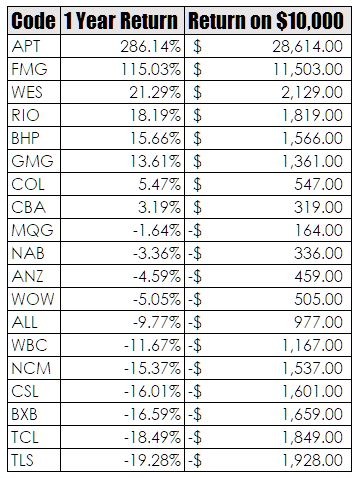One of the mistakes that new traders make is they hold the belief that the market will give them a salary much the same as any other employer would. When in fact the reality is very different – returns from markets are very lumpy and in part, I think it is this staccato nature of returns that draws many to short-term time frames. They believe generally erroneously that the market will provide them with a regular income if they truncate the time frame enough and this idea is generally accompanied by the notion that all they need to do is make 1% per week – after all how hard could it be to simply make 1%.
In reality, trading performance is dependant upon outliers. Recently I was having a look at the performance of the ASX top 20 to get a sense of how the buy and hold brigade would have fared over the past year. The details of this can be found below.

As you can see there are only two true outliers in the group – APT and FMG and whilst the return of WES, RIO and BHP are solid they are not headline grabbing.
In addition to generating the raw return I also looked at the value of $10,000 invested over that year. If you had an equally weighted portfolio with each stock having an allocation of $10,000 at the end of the year you would be up $35,676.00 or 17.8% which is better than the index for the same period. However, if you had some form of money management protocol that dropped a stock and went to cash when its value fell 5% then you would be up $46,899.00 or 23.4%. Granted generating real returns is not as easy as simply looking at year-end figures and selecting which one’s to drop retrospectively but it does as a thought experiment demonstrate the need ot drop losers and keep winners. A lesson that should be obvious to everyone.






It’s easy to spot the outlier performance growth stocks in retrospect. The challenge is to identify these potential multi-bagger stocks as early as practicable. Weekly charts with a ten-period MA line assists with identifying breakout above consolidation or resistance, for example, a one or two year new high. The other challenge is when the trader’s portfolio is already full of instruments trading at one year new highs. A trader can’t buy everything that is trading at new highs. A trader has to be content with a profitable portfolio, and be realistic that they can’t own everything that is strongly trending up.
I would posit that it is not actually about identifying them in advance but rather having an approach that ditches losers at a predefined point and concentrates on those that are not losers. Eventually, over time the system will end up with a handful of outliers simply as a function of you having survived.
Chris
I have often wondered what would happen if one bought a random 20 stocks out of the ASX300, sold any that lost 20% from a weekly high and replaced them with another random stock. I actually do something similar to this but use new annual highs as a buy signal but I often think the buy signal is just a comfort blanket rather than any form of predictor of how well the trade may go. Have you ever modelled anything like this?
I have done a lot of modelling with these ideas. The quick takeaway is buying a portfolio of stocks at 52 week highs will outperform a random portfolio given the same position sizing and stoploss rules.
In fact, buying stocks at 18 month or two year highs works even better.Price strength is a great indicator of more strength.Some people say that entry is not important. I agree to a point.A well managed random portfolio can be profitable, but stocks showing annual highs have an edge over those that do not.
Thanks